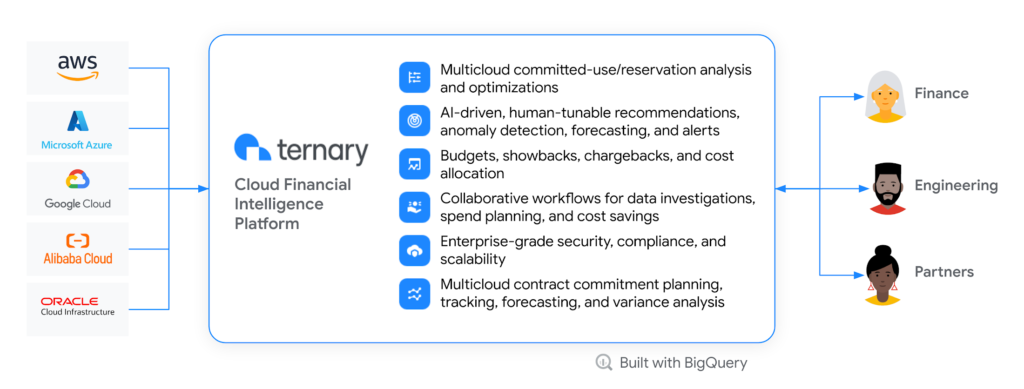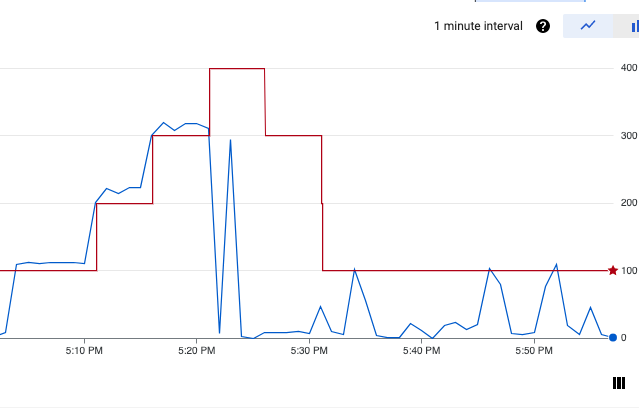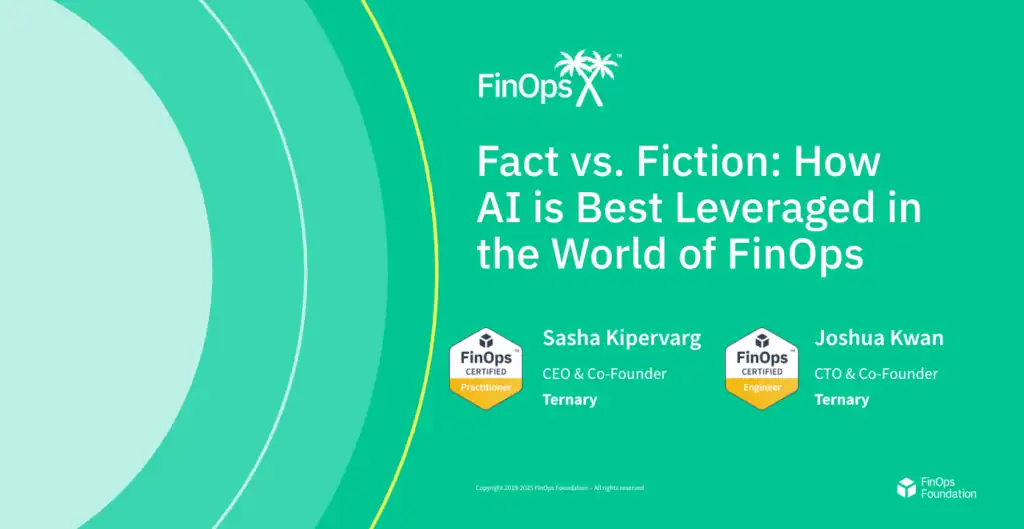How can your company scale profitably in the cloud while spending to plan? And what do you do when your company’s cloud bill spikes unexpectedly? Ternary securely ingests, retains, and queries cloud billing data on behalf of its customers—from fast-growing tech startups to the largest of enterprises—to provide ML-powered visibility and planning capabilities for an entire organization’s cloud spend.
Ternary makes sense of cloud bills
Your cloud bill may span multiple service providers and potentially millions of data lines per day. Like many of Ternary’s customers, juggling myriad accounts and projects, you’re probably too busy to compare each cloud’s profitability, let alone comb those data lines for what caused an unusually high bill. Ternary partnered with Google and the Built with BigQuery initiative to address these pain points.
Ternary starts by ingesting and analyzing data from a customer’s cloud service providers (including Google Cloud, Azure, AWS, Alibaba, and Oracle). Then, using class-leading Custom Labels, the customer’s finance and engineering teams can organize the data independently, tracking line items relevant to their jobs within the cloud bill (e.g., cost center, for finance; tech owner, for engineering).
Finally, Ternary ingests your business KPIs from systems like Datadog and Snowflake. By combining your KPI data with your cost data, Ternary helps customers finally understand their unit costs for cloud spending, such as “cost per cart” or “cost per request”—and how to use those insights to drive profitability.
A solution for out-of-the-blue spending spikes
But what about unexpected spending increases? When a customer chooses Ternary, the platform uses machine learning to model their typical cloud spending. Then the Alert Tracking feature flags any unusual spending (e.g., spiking API usage), so customers can take corrective steps before it becomes a bigger problem.
Of course, spend management tools are helpful only when they’re cost-effective themselves. Other cloud spending platforms may require long onramps and costly consultants to integrate the new “solution” into their systems and to render reports relevant to particular business units’ use. But with Ternary’s consumer-friendly platform, customers can start getting customized insights the day they deploy the software—no consultants required. Rapid time to value is a key reason customers choose Ternary, together with the infinitely scalable insights the platform unlocks.
Ternary assembles and manages your multi-cloud master ledger
Ternary provides customers with a master ledger that consolidates billing data from customers’ cloud service providers, ISVs, and other data sources. It’s a single pane of glass that surfaces actionable insights each member of a company can customize to their needs.
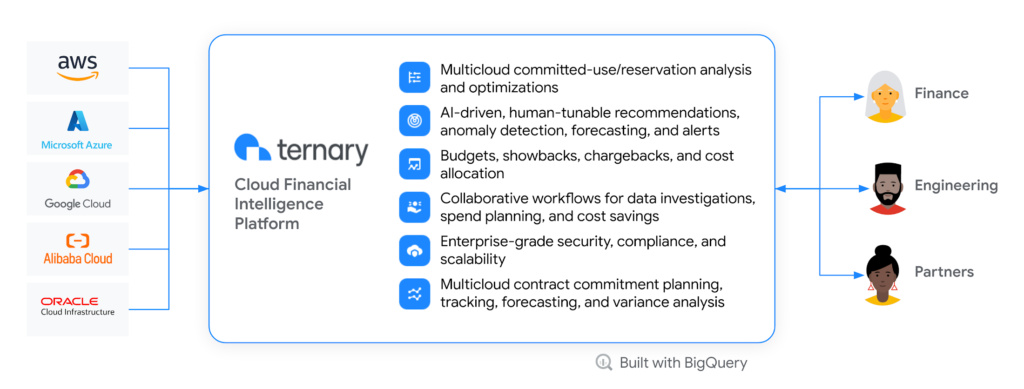
Multi-cloud customers appreciate being able to point Ternary at their data sources and effortlessly query and report against them, knowing that all of their company’s cloud providers and payer accounts are fully represented. Ternary uses the ELT pattern to bring unmodified data from all over the world of cloud into Cloud Storage, in a variety of formats (JSON, Avro, Parquet, CSV), and loads that data from Cloud Storage into BigQuery.
Later on, Ternary uses SQL transformations to turn this original billing data from cloud providers into multi-cloud production tables under one common billing schema. Customers value being able to interact with the data from all cloud providers at once in Ternary’s web platform, while still being able to analyze the full detail of each cloud provider’s raw bill individually.
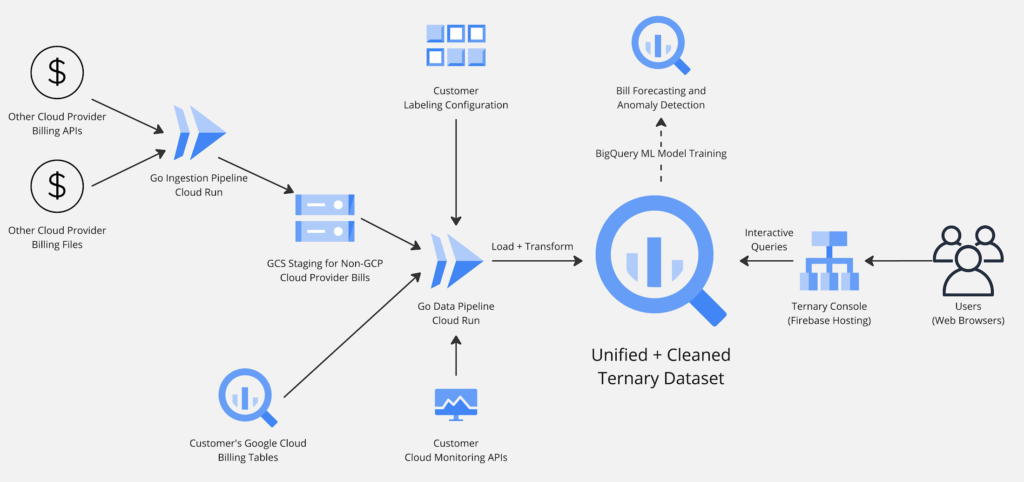
Ternary is built with BigQuery
Ternary’s customers love how the platform’s intuitive views marry cost data to utilization data in ways not found in other cost management platforms (and which would be quite a burden to do oneself). Using BigQuery’s flexible data-loading methods, Ternary takes data from monitoring systems, such as Google Cloud’s operations suite and Datadog, and writes them to tables in BigQuery for future use.
Also, as a serverless data warehouse, BigQuery allows Ternary to store large amounts of data—organized and unorganized—within Google’s cloud infrastructure. With BigQuery, there’s no need to allocate compute environments to them at all times, which can be the case with other solutions in the market.
Last but not least, BigQuery provides security that any Ternary customer can use to build at enterprise scale. By permissioning tables and datasets with the full expressive power of Google’s IAM, Ternary securely retains customer data while maximally avoiding “commingling” data among customers. By default, each Ternary customer gets a service account and dataset, and each BigQuery table used for that customer can be read and written to only by that service account.
Class-leading automation and human-tunable customization
Let’s take a look at how BigQuery powers Custom Labels and Anomaly Detection—two features that have helped Ternary grow to more than 340 active enterprise customers since the company’s 2021 launch.
Composed of Agile advocates and DevOps experts who have seen the pain of overshooting cloud budgets, Ternary’s team knows the pitfalls of running a large organization in the cloud at scale. Part of the difficulty is tagging and tracking line items in a complex cloud bill that’s constantly changing: When data that aggregates cloud accounts and projects by business unit becomes outdated, your cloud bill isn’t retroactively updated to match, making the process of tagging temporary at best.
Ternary resolves this difficulty with Custom Labels, which customers use to apply last-mile modifications to the labels within customers’ raw bills, line by line. These same labels are automatically applied to all of a customer’s cloud accounts, without the customer having to retag underlying resources. If a customer changes a label, the change populates throughout the customer’s cloud bill, and, with the help of BigQuery, Ternary renders the updated data as a new table.
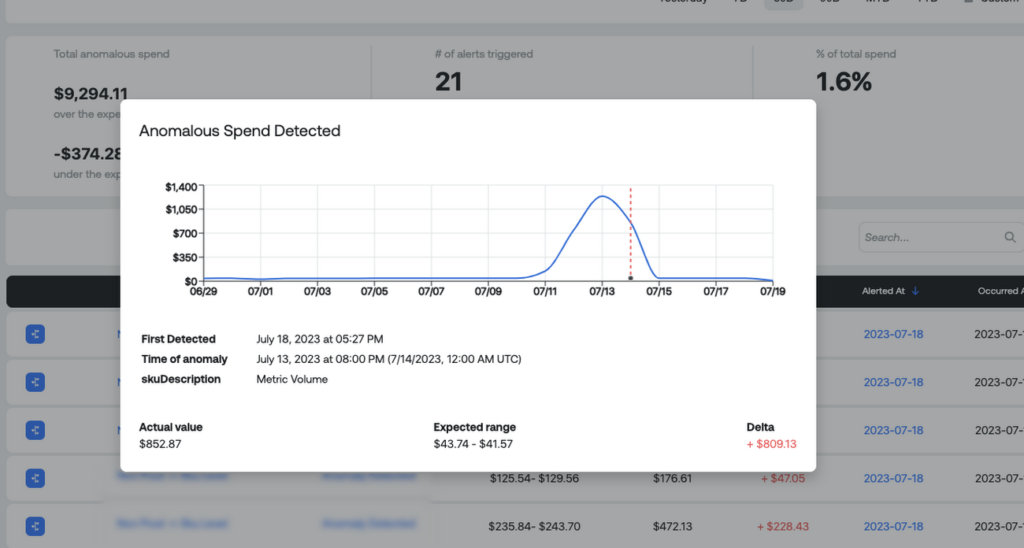
BigQuery also drives Ternary Anomaly Detection, shown in the screenshot above. Our ML-powered alerting system allows users to pick the way of bucketing their costs that makes sense for them. Then, our ML engine alerts the customer if any of those buckets has anomalous spend (or spend that is predicted to exceed a threshold). BigQuery ML ARIMA_PLUS functionality allows Ternary to analyze all ingested cloud-billing data sources inside BigQuery, without needing to export the data to a separate ML platform.
How Decisions tracks cloud spending with Ternary
To appreciate how Ternary empowers customers to solve cloud cost challenges, look no further than Decisions, a Virginia-based Intelligent Process Automation platform. Decisions helps clients (from midsize companies to Fortune 500 corporations) build software with drag-and-drop ease so they can automate and orchestrate business rules, workflows, and artificial intelligence.
When Decisions’s Senior Director of Technology and Delivery Pravash Mukherjee discovered Ternary’s platform he “thought it was too good to be true.” A single source of truth is exactly what Ternary provides for Decisions’s $200K in monthly cloud spending across Google Cloud, Azure, and AWS. Immediately upon signing into Ternary, Mukherjee can access a depth and breadth of data—from daily trends to 30-day net spend—that would be impossible with manual processes or by logging into individual customer accounts.
“Within an eyeshot, I can look at the gross cost by project; and, as soon as there’s a delta, I can see it,” Mukherjee explains. And, he adds, Ternary’s Alert Tracking feature has been instrumental in monitoring those cost changes. Its built-in parameters have so far been exactly what Decisions needs to surface and investigate changes in spending (and, if that changes, Alert Tracking can be customized accordingly).
Overall, Ternary plays a critical part in Decisions’s FinOps journey. “It saves me man-hours that I no longer have to spend scrutinizing whether [cloud cost analysis] was done correctly,” Mukherjee says. By using Ternary to track daily, monthly, and annual cloud spending, Mukherjee can help ensure that Decisions hits the 80% gross profit margin so essential for SaaS business growth. It’s just one example of how Ternary helps customers not just save money but also position themselves to grow.
Ternary can help you tame your cloud bill
Ternary is the leading platform in its field, managing billions of dollars in customers’ cloud spending. Ternary’s AI-powered, human-tunable recommendations typically identify opportunities for cost savings between 15% and 60% of customers’ cloud spend.
Read the original post on the Google Cloud website.
Learn more about how Ternary can support your company’s growth.

